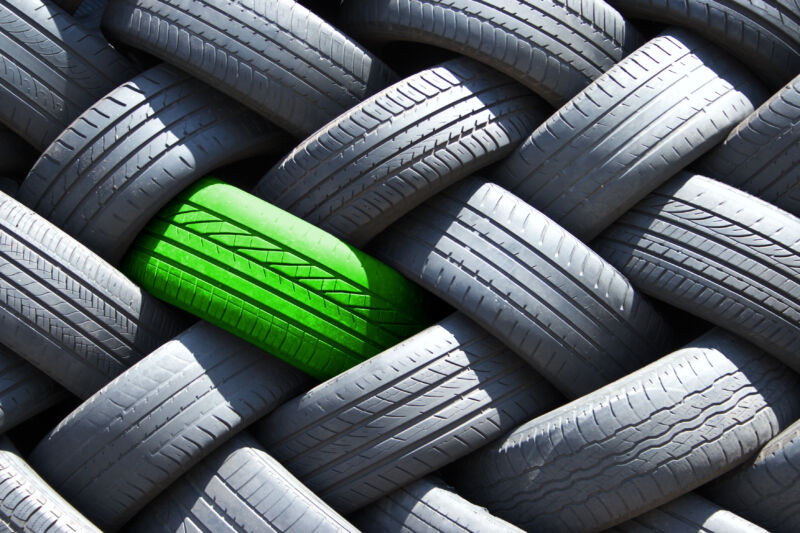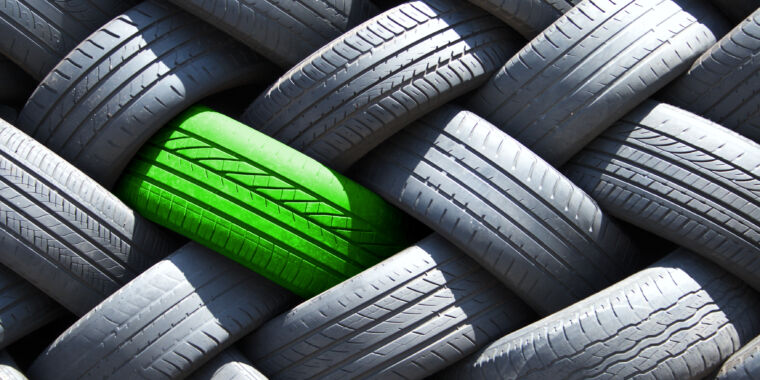Here’s how Michelin plans to make its tires more renewable

Enlarge / Tires are a growing source of microplastic pollution. Michelin says it wants to change that.
Getty Images
Reduce, Reuse, Recycle—it’s more than just a fun alliteration tagline. It’s also a set of instructions for how to consume in a way that’s less destructive to our environment. We reduce our consumption and reuse what we already have, then recycle it once it no longer has any use. Unfortunately, many are going straight to recycling and calling it a day.
At its sustainability summit in Northern California at the Sonoma Raceway, Michelin laid out a new roadmap for its plans to become a more sustainable company. Most importantly, the company shared what it’s been doing for decades to reduce the harm done to the world by its tires.
The company reiterated its desire to have 100 percent renewable tires by 2050. Companies make a lot of pronouncements like this, and they only sometimes come to fruition. But looking at Michelin’s present efforts and past record, the company has a decent chance of succeeding.
The now
Michelin currently has a demonstration tire made of 42 percent renewable materials. The company has plenty of time to reach its goal in 2050, so it’s trying to make the change in the most profitable way possible.
“We are guided by a sustainable world view of organizing principles that is in every business decision we make. We balance it across three domains: the people, the planet, the profits,” Michelin North America President and CEO Alexis Garcin said during a presentation.
The “People, Planet, Profit” principles emphasize eco-consciousness but also remind everyone that Michelin is a company that needs to make money to keep tires rolling off the lines.
During the event, Michelin said that its research into more sustainable tires requires teams to show that the materials they use are readily available and that the tire can be produced at scale. This is a vast improvement over companies that unveil unrealistic, feel-good items that won’t ever see production.
The then
In 1992, Michelin introduced its first fuel-efficient tire. It had a lower rolling resistance, allowing drivers to potentially save money on gas and reduce their carbon footprint (although, to be fair, most probably didn’t think about that).
The company has been stress-testing the stuff that goes into tires, too. In 2019, it introduced new racing tires for IMSA’s WeatherTech Sportscar Championship that used 30 percent renewable and recycled materials, with no real drop-off in performance.
There’s also the reputation for longevity. According to a 2023 study by the German ADAC (Allgemeiner Deutscher Automobil-Club—think Germany’s AAA), Michelin’s average tire abrasion rate was 28 percent lower than the rate in average tires from other brands on the road in Germany.
The abrasion rate is how much of the tire is shed while driving. The higher the abrasion rate, the more particulates are left on the asphalt, which migrate to the soil and eventually end up in the water supply. Much has been said about these particles that have permeated our environment, little of it good.
Tires are a major source of microplastics, and as our vehicles get larger and heavier due to an insatiable appetite for large vehicles and our transition to EVs, tire companies have a spotlight on them to reduce their product abrasion rates. Here, Michelin seems to be ahead of the curve.
The later
Eighty percent of a tire’s environmental impact comes from the time that it’s sitting on a vehicle. Building a more sustainable tire can’t be done by just relying on different materials, especially if those materials wear down quicker than what’s already on the road. Michelin’s lifecycle assessment looks at the cradle-to-grave impact of a product as an ecosystem.
“For us, it’s people, profit, planet. We care about all of them at the same time with the same intensity, and that’s how we think we’re going to be sustainable,” Garcin said. If the company keeps sight of the goal, it might just pull it off.
Here’s how Michelin plans to make its tires more renewable Read More »
